
views
Before you start
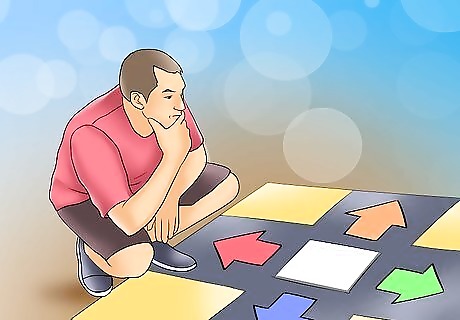
Understand that the point of DDR is to match your steps to the moving arrows as they reach the top of the screen. As long as the machine is in good working order, you will not need to stamp your feet for it to register a step. It is all about timing. Stamping your feet violently will only tire you out and hurt your feet.

Use appropriate etiquette. Do not disturb someone while they are playing. Wait for them to complete the song or their game and then have a word with them. It doesn't matter how good you are, do not make fun of new players. You should encourage them to improve. If you have a huge ego then you will never progress past your own faults, but if you coach others, then you will be respected and admired as a true DDR master.
For Beginners

Choose your song wisely. Look at the number of "feet" displayed on a scale of 1 to 10 at the bottom of the screen. The higher number of "feet", the harder the song will be. In newer versions, stepcharts (levels) are rated numerically from 1 to 20, instead of 1 to 10. The rest of this article uses 1 to 10.

Recognize that different songs can have a different tempo. This is rated in beats per minute, or BPM. The higher the number, the faster the song will be. Determine what speed you are comfortable with. Some songs change tempo during the course of play. All of these factors are displayed on the screen where you select songs. BPM is not equal to difficulty (i.e. slower songs may have harder stepcharts than faster songs), but it changes the speed at which the arrows move up the screen.

Vary your selection. If you pick the same song every time, it often locks you into bad form, and usually annoys other players. Only do this if you are new to the game. To really improve once you start playing Light/Basic (yellow) and Standard/Difficult (pink) difficulty, you should play a larger variety of songs to learn new patterns.

Feel the rhythm. Use your knees to bounce with the character on the screen, or as the lights flash on the machine. Once you've gotten that down and you've moved to Light, you can begin to actually dance along with the beat before you finalize your song selection.

Don't return to the middle! This is very important. The tutorial shows the character standing on the middle of the platform, but to play any song harder than about 3 feet, your "ready" stance should stand mainly on the Left and Right arrows. The game does not penalize you for stepping on an arrow if there isn't one on the screen, only for stepping out of time or not at all; with this posture you'll be much more prepared for the arrow patterns.
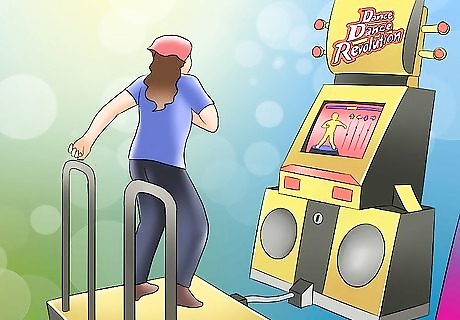
Use both feet! A lot of beginners will use their dominant foot for 3 panels and keep the other foot still. For example, a left-footed beginner would use their right foot only for pressing the right arrow. This is bad form! You must learn to use both feet on more than one arrow. It can save energy in patterns like "down up down up", and gives you an advantage when you play on harder levels.

Learn to shift your weight as you step. For instance, suppose you are given the steps "Right Right Right." The best way to do this is to keep your weight on your left foot, while tapping the right button three times with your right foot. This avoids the common beginner mistake of shifting one's weight onto the right foot after the first step, causing one to have to hop to hit the right button again, and often being thrown off balance. Similarly, suppose one is given the steps "Right Left Right." This is best done by walking on the arrows, shifting your weight to each step as you hit it. This avoids the mistake of keeping your weight on the right arrow the whole time, which would make it easy to tap the left button but would force you to hop to hit the last right button. Most of the beginner songs consist of steps that can be done by some combination of "walking" from arrow to arrow, and tapping an arrow if that step is repeated, and these are the techniques you need to learn before you can do harder songs.

When you play DDR for the first time, try taping yourself. It's a great way to see how much you've improved! Then, after playing the game for a solid time, tape yourself again. When watching the beginning tape, don't criticize yourself. Watch the new tape and you'll see how far you really have come!

Do not learn to play just one song perfectly to show off! It may look good if you are playing a home game, but at an arcade, you get 3 tries. Playing the same song 3 times in a row will just show people you want to only show off! Step outside your comfort zone! If anybody teases you, ignore them. They were beginners once too, or they haven't ever played it! Never underestimate DDR. It's far from as easy as it looks!
For Standard/Difficult
Use speed multipliers (also called speed mods). Hold down the start button when you select your song (On newer versions, press 9 on the numpad), and an options screen will be displayed. If you like your songs fast, do 2x. If you like your songs average/fast, do 1.5x. Although speed mods make the arrows move faster, they add space between arrows so crossovers and other complicated patterns are easier to read and react to.
Speed mods multiply the base scroll speed, which depends on BPM. For example, a song at 100BPM with a 2x speed mod, and a song at 200BPM with a 1x speed mod, have arrows that scroll at the same speed, which we call "200 scroll BPM" or just "200 BPM".

Some players, especially those who started early on in the series, frown on speed mods, just as some players frown on using the bar for support. It is important to remember that speed mods and the bar are there for your assistance. There is no one way to play DDR, so do what works best for you.

Learn the difference between the steps. Eighth notes are twice as fast as quarter notes, the basic beat of the song. A common step pattern on Standard is three notes at double speed (think, "one and two, three and four."). You'll definitely need to be off the middle of the pad to get these steps (see #5 above). Try to listen to and use the rhythm of the song, and gradually you'll master it. (A straight run of 8th notes is counted "1 & 2 & 3 & 4 &".) Eighth notes will be colored differently from quarter notes. On the "Note" color setting, quarter notes are red while eighth notes are blue. On the "Vivid" color setting, the color cycles with an offset phase.

Work on mastering 16th notes. These occur exactly halfway between the timing of a quarter note and an eighth note, and are usually packed tightly together on the screen. Using Speed Multipliers to spread them out will greatly help your ability to "read" their rhythm. (A straight run of 16th notes is counted "1-e-&-a 2-e-&-a 3-e-&-a 4-e-&-a". You'll rarely see this pattern on Standard; usually, what appears are groups of three 1/16th notes in a row. Count this pattern as, "1-e-&, 2-e-&, 3" or "1 &-a-2 &-a 3", etc. depending on when it happens.) Another common pattern involving 16th notes is what is called a dotted 8th note in music theory. This involves arrows that are 3 16th notes apart (3/4 of a beat). They may appear in groups of 3 or 5.

Practice crossovers. Crossovers are steps where you have to turn your body sideways and cross one leg over the other to successfully "walk" along the steps. For instance, for "left down right down left", you should cross your left foot over to hit the left and right arrows. Crossovers are the first of the more sophisticated stances.

Gallop. Galloping is where you, well... gallop. These are technically 1/16th notes grouped 2 at a time. (They are counted "1-e, 2-e" or "1 a-2 a-3", depending on the timing.) You jump in the air and once you land one foot, you land the other on the opposite arrow a quarter beat afterward. TSUGARU APPLE MIX (DDR Extreme US, DDR MAX 2 and DDR EXTREME arcade) and also COWGIRL (DDR MAX, MAX2, Extreme arcade) are great songs to master this. Japan on Heavy is great to learn Galloping because it often has long rows of gallops using only 2 arrows and in some parts more advanced galloping with the arrows going all over the place. However it doesn't have any forced crossover gallops or forced spinning gallops so it should be all good.

Sometimes it's hard to see gallops in the middle of a stream of arrows. Using speed mods will make them easier to read, as will changing the noteskin to Note (in older versions called Solo). The home version also has an option to use different colored note-skins, called Type2. These different colors making picking out gallops trivial.

Be aware that some songs have specific tricks: Some songs use triplets. Triplets are notes that fall one third, one sixth, one twelfth, five twelfths, etc. of the way between beats. For example, Burning Heat, and the end of Afronova. If you don't know triplets, search YouTube for those songs, and it should be fairly clear which notes they are. Practice them. Other songs, such as Healing Vision (Angelic Mix), sometimes use a Stop. This means that the arrows pause for a beat.They literally stop on the screen for a half second or so. Some songs change speed in the middle. Sometimes you might see arrows closer together or farther apart and learn to ignore it, it's the same tempo, the arrows just change speed on the screen. The specific instance of the speed doubling or halving in the middle of a song is called a soflan, named after the song Soft Landing on the Body on Beatmania IIDX.
For Experts

Progress to even harder songs. Once you are comfortable with a lot of Standard difficulty songs, start doing some 6-foot Heavy songs. As you master the new moves that are required, you'll be able to move your way up to 8 footers, to 9, and then 10.

On really hard songs, using the bar behind you to balance can help a lot. Although its necessity is debated and frowned upon by some players, it could be useful. For Beginner, Light, and Standard, the bar really isn't required.

For your final song, try a hard song that you might not normally be able to finish. If you keep doing that, you will eventually be able to finish a new song, and increase your repertoire.
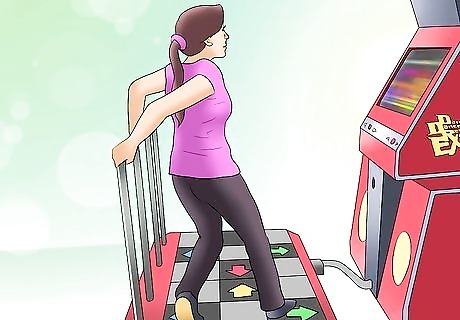
Try to learn some of the most complicated step patterns that you can do while "walking" or always switching feet. The song Rhythm and Police (4th mix) is an excellent one to learn slowly and work up - it contains most of the complicated step patterns that require no more than crossovers. The song Afronova (3rd Mix) is good for teaching more complicated stances, such as having to turn 90 degrees to the left to be able to hit "Left Up Right Left Down Right Left Up Right Left Down Right..."

Learn to use your heel as well as the ball of your foot. This technique is sometimes called playing flat footed. For instance, have the ball of your right foot on up, and the heel of your right foot on right. Now, assume you have the step pattern Up-Left-Right. Hit up with the ball of your right foot, left with whatever part of your left foot is easiest, and right with the heel of your foot. Since you move your feet a shorter distance, you expend less energy and move more quickly.

Try not to think too hard while playing. This may sound counter-intuitive, but it may be much easier to play when you're not thinking about playing! Your body will go for the notes more naturally if you don't think too much! It may sound crazy, but it could work for you.
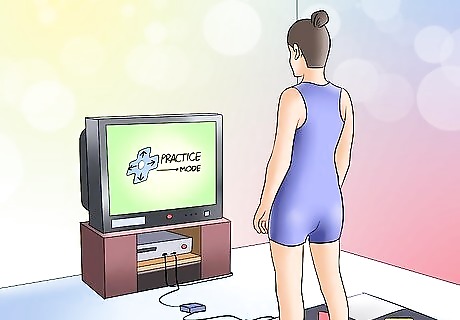
Use practice mode. If you have DDR for a home console, slowing down a song by a few percent can really help you learn especially tricky sequences in songs.

Understand that stamina is key. For those that get technical, if you find yourself stuck on a certain foot level, like 7 feet, then try the following. Set the song list to difficulty(arcade machine), which will categorize the songs according to the number of feet. Find the level your on, and start abusing that list. By the time your able to pass every song on B or higher for that level(mainly for 7 feet and below), you should be able to start playing on a higher difficulty. Note that after you start playing 8 feet or higher, you should be able to pass all the songs with an A before you move to the next level.

Know that skill level and stamina level are equally important. Generally speaking, it's one thing to have the skill to play songs that are above your level and pass (even if barely), but if your legs give out before the song is even over, then focus on stamina. It won't matter how many advanced techniques you know unless you get a good balance between both in the higher levels.













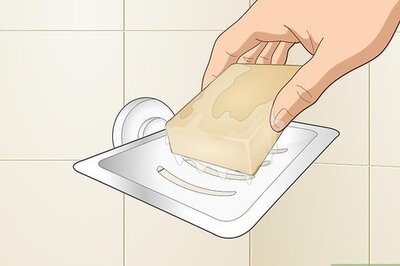

Comments
0 comment